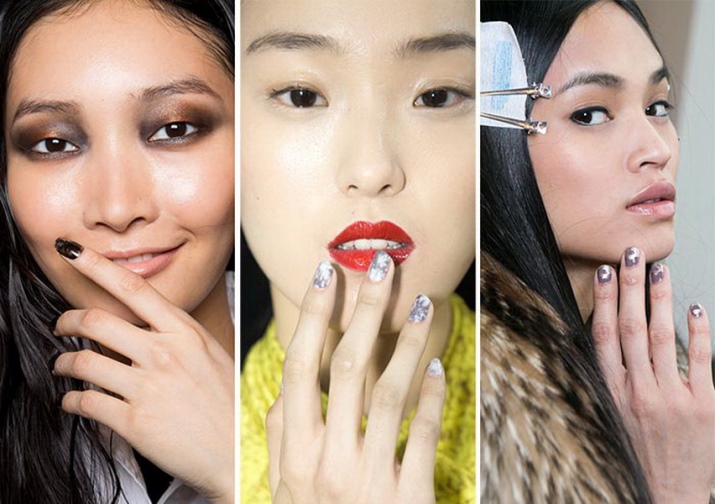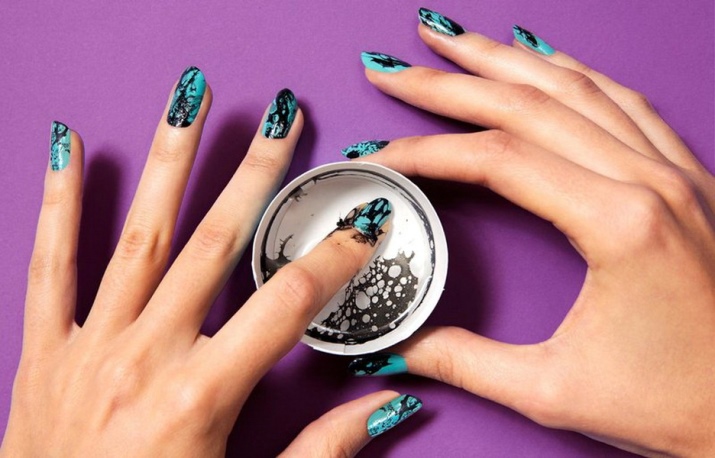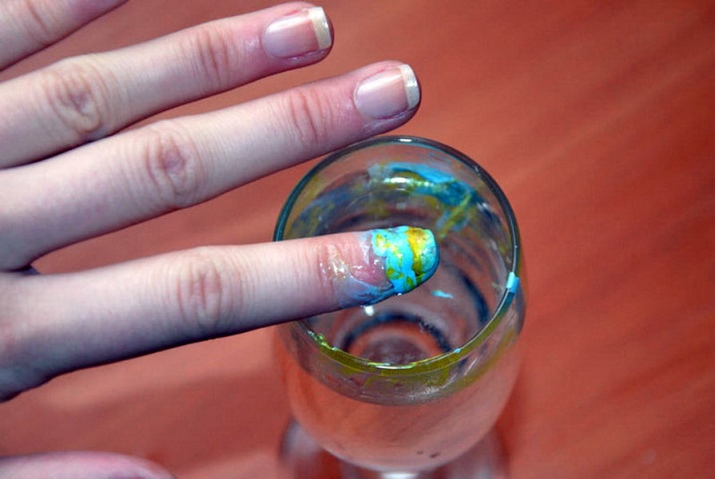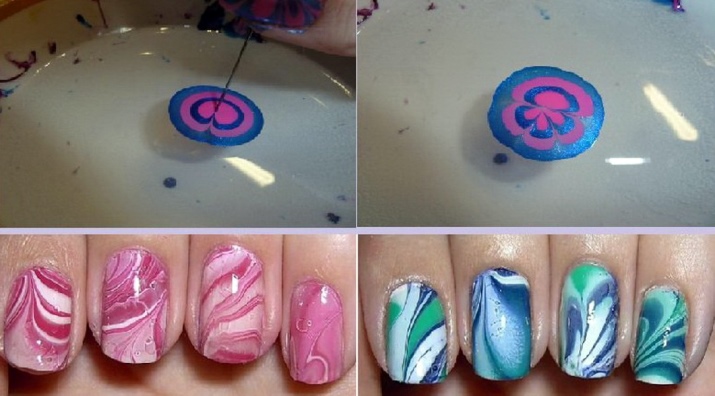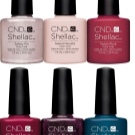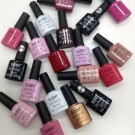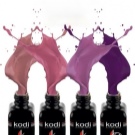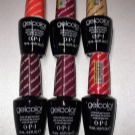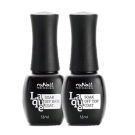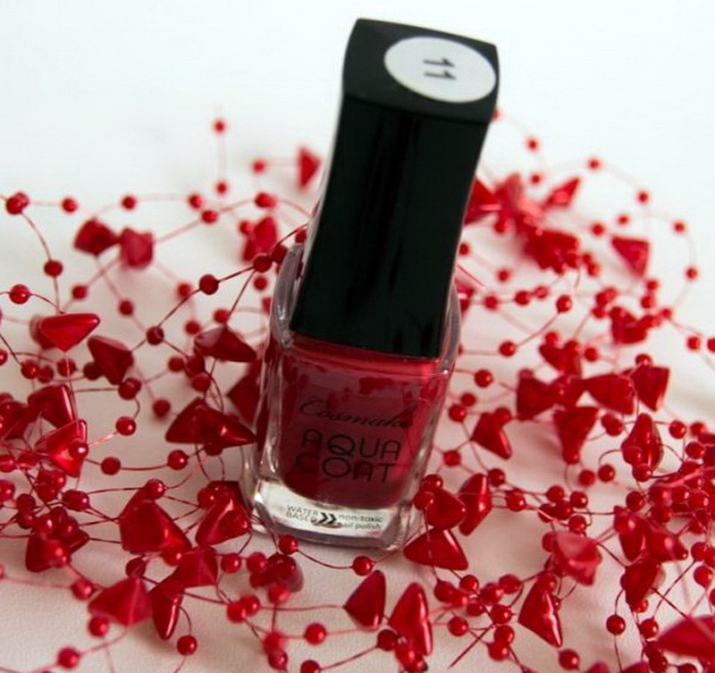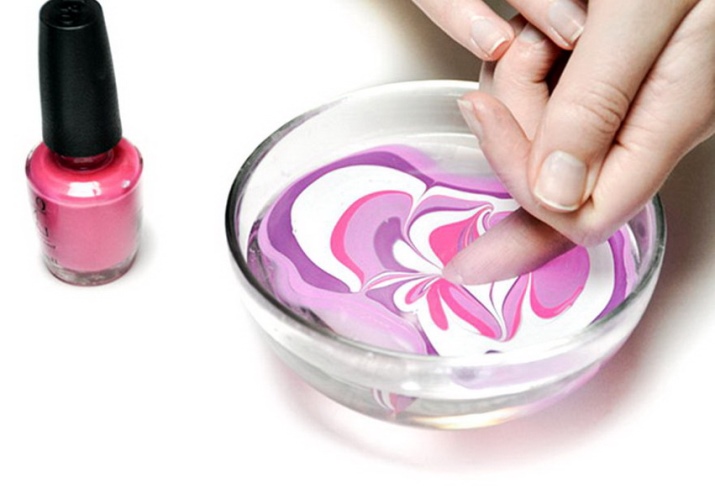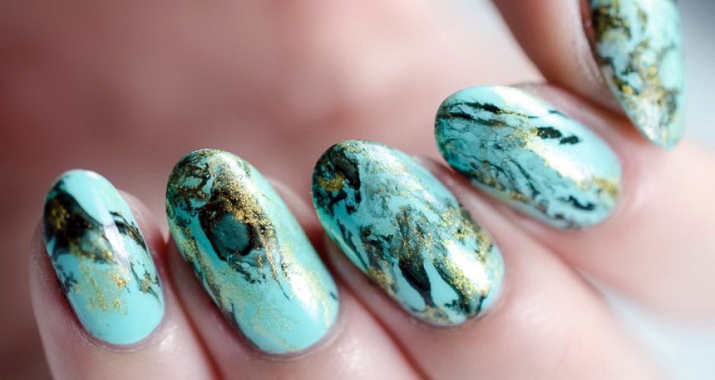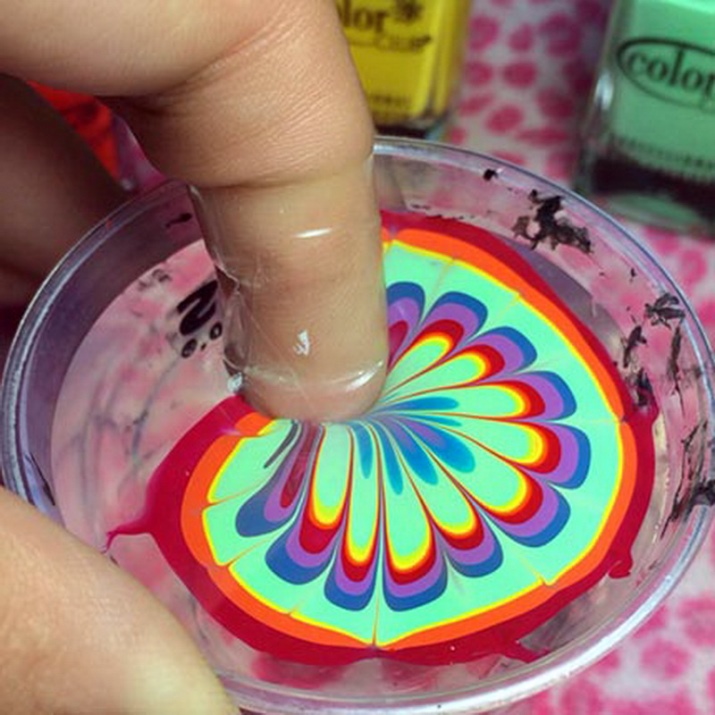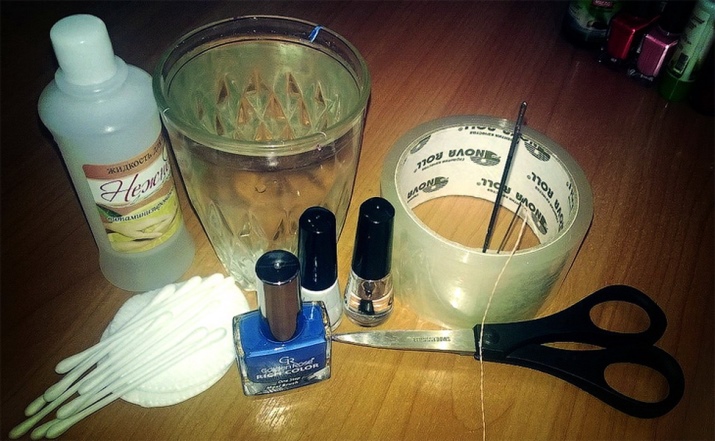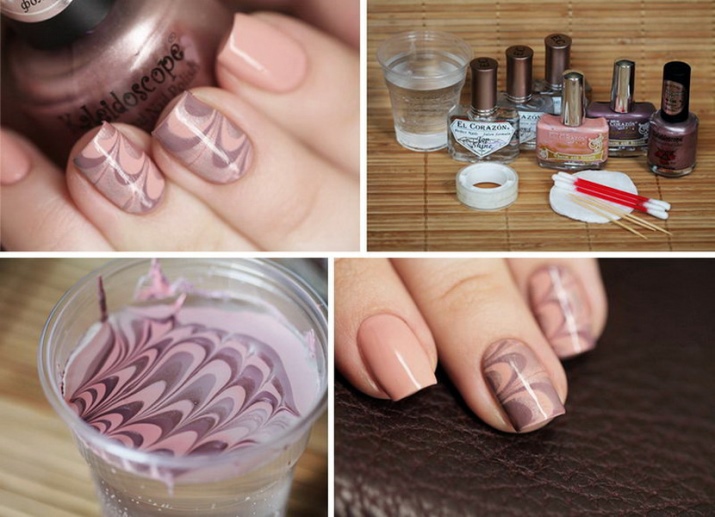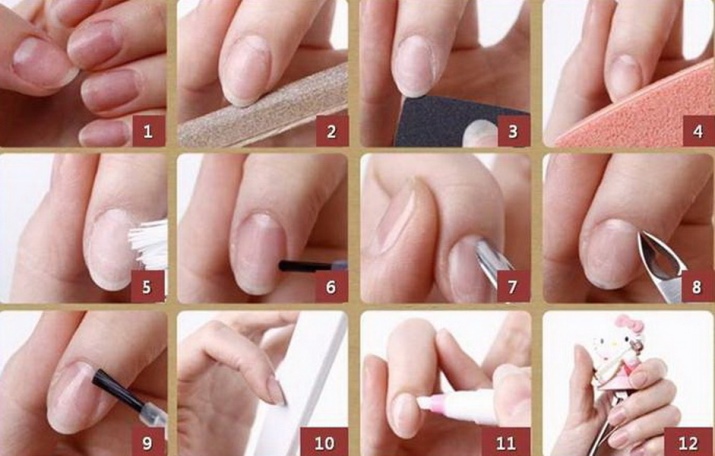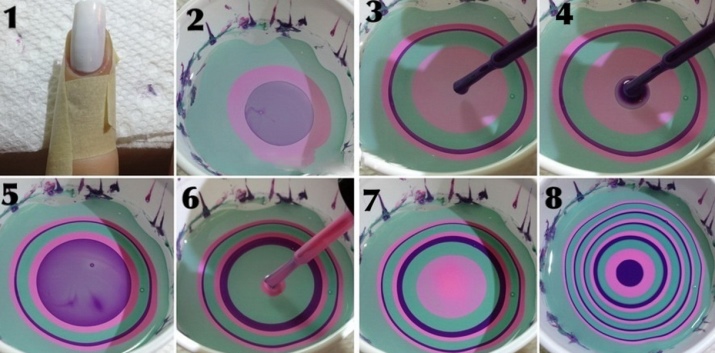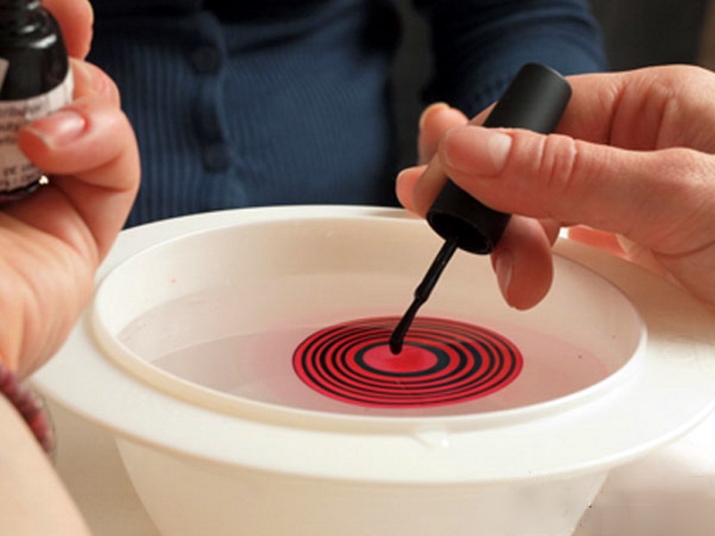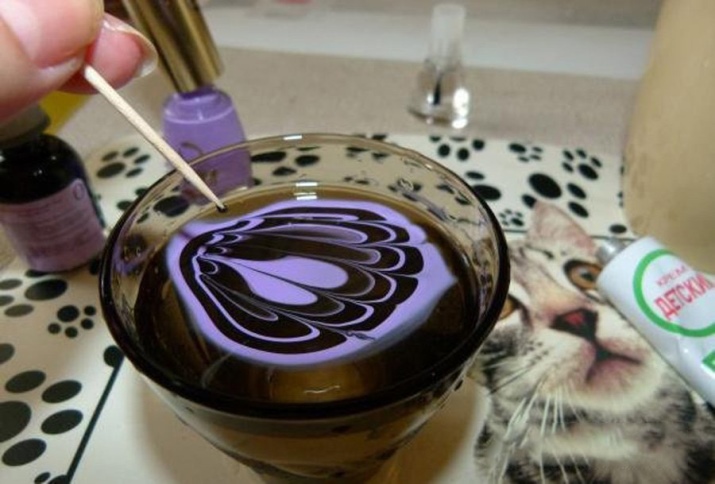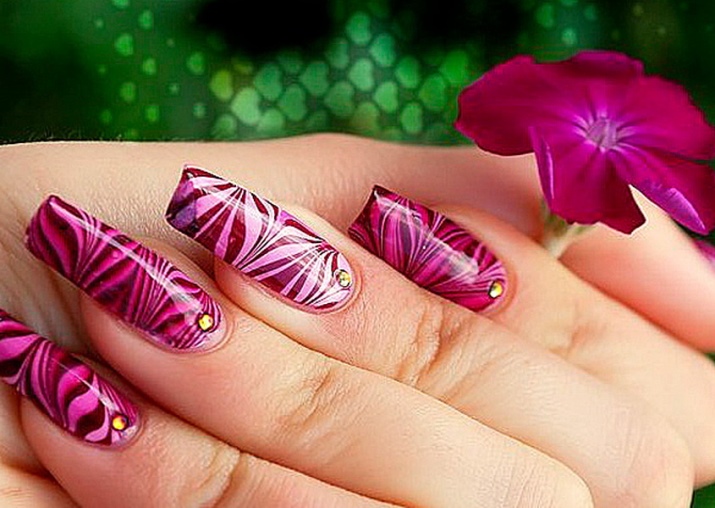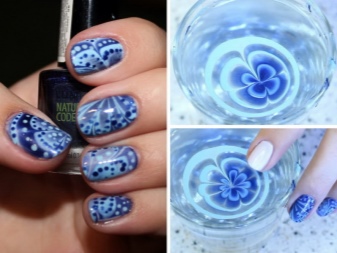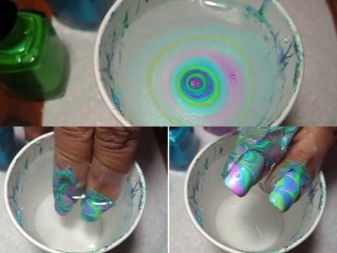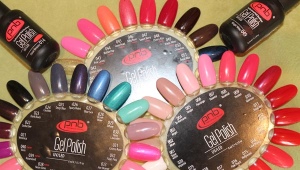Water manicure gel varnish
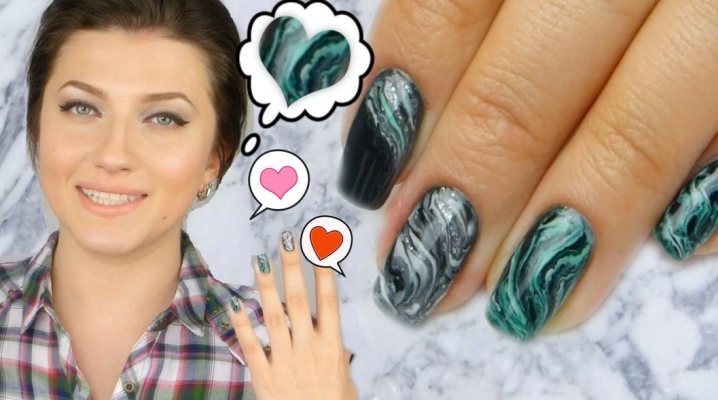
Well-groomed female hands and nails with an interesting design speak about the attitude of a woman towards herself. If you are tired of a monochromatic glossy gel polish, we recommend to get acquainted with the water manicure and simple technique of its implementation, which will be able even to a beginner.
What it is
Water manicure is performed using a liquid and allows you to create the most original patterns on the surface of the nail plate. This type of coating is often called marble manicure for the ability to display the structure of natural stone in design, but women do not always prefer to wear “dull marble"And choose shades brighter. Water manicure designs are suitable for nails of any length and shape, chosen shades play an important role - they should be combined with each other or create a stylish contrast.
Often the question arises about what kind of varnish is needed to create a water manicure. The answer is any fresh gel polish. It is not recommended to use too thick dried composition - it will be difficult and almost impossible to draw on it due to its high density, and the natural spreading effect may not work. To create a design, it is necessary to form a pattern right in the water - this will allow you to get an interesting pattern and put it on the nail plate by lowering it on the pattern.
In order for the water design to succeed, you must use fresh varnishes and apply them to the water one drop at a time. - first one pigment, then another, optional third and fourth. It is recommended to use 2-3 shades, maximum 4. To create a black and white design, you will need only 2 colors and 5-6 drops, which are superimposed on the water in turn.
Manufacturing companies
To create the original water design fit the usual gel polish is not a thick consistency. It is desirable that the shades have the same manufacturer - this will guarantee their uniform consistency and better distribution when drawing. Examples of suitable brands include:
- Shellac CND;
- OPI Gelcolor;
- Kodi Professional;
- Bluesky;
- Laque RuNail.
Aqua Coat special lacquer is normal, it has a watery texture and is safe to use, especially for allergies, pregnant women and children.
Design
- Black and white. The design will require two colors: white and black. In a prepared container with water, drop a drop of black pigment, in the center of it a white trace. Alternate the application of drops 3-4 times. The resulting circle in the circle can be applied to the nail directly in a “clean” form or create a drawing with a needle;
- To obtain a natural marble effect, use white lacquer or any nude hue as a basis; - black, dark gray, brown and even green or emerald. The nail plate in advance can be covered with a monochromatic light coating, in water dissolve the same or a different shade for a couple of tones, drop a drop of contrast pigment into it. On the light background, draw the wrong lines, reflecting the structure of the natural stone. You can use several pigments from one palette;
- «Malachite"- the original design, which is perfectly complemented by gold. The basis is taken green, emerald green, turquoise gel polish: one large drop is applied to the water surface, on top - a little white, golden and any dark lacquer contrast.
- Bright summer design combines the most current shades. You can not be limited to tones, and choose the most rich colors: blue, green, yellow, orange, pink, lilac. Apply color after each other, after forming a pattern. In this case, it is not necessary to observe the same technique of the figure, asymmetry takes place here.
The format of water manicure allows you to use varnishes of any shades and boldly combine with each other. The coating can be further decorated with decorative ribbons, rhinestones, holes, beads, or left in its original form.
How to do at home
To create an original water house design, you need to arm yourself with materials:
- Convenient storage and room temperature water. For beginners and even masters, it is recommended to use disposable cups - it is not a pity to throw them away after the procedure and damage during, and unhygienically, dilute synthetic compounds in your favorite circle;
- Toothpicks, thin knitting needles or skewers. They are useful for drawing a pattern on the water and the surface of the nail;
- Fatty hand cream, cotton pads, sticks or a special protective cuticle mask film.
Mandatory "working" accessories are:
- Transparent base and top cover;
- Gel shades of several shades (it is desirable to choose no more than 3-4 colors).
Now let's talk about how to make a water manicure yourself:
- Prepare the marigolds: make a classic manicure, shape the nail plate, remove the cuticle and treat the surface of the nail with a buff and degreaser;
- The first layer is a transparent base. It must be dried in the lamp and only then proceed to the main step. By the way, until the next item you need to treat the area of the cuticle with a fat cream in order to remove excess pigment from the skin. Masters recommend applying a fat product or a special film before applying the base, but you can do it after;
- To start creating and applying a water pattern, drip a drop of gel polish of a selected hue from a distance of no more than 2 cm above the water surface into a container prepared with water (otherwise the drop may just sink). Then drop the second, third drop, you need to direct the drop to the center of the previous one.
- Create a drop pattern with a fine needle, toothpick, or any other tool. Connect the pigments together in a circle or distribute them with a needle in different directions - the imagination here is limitless;
- To create a truly unique pattern, we advise you to dream up in advance;
- After creating the picture, dip the nail in it - strictly parallel for the quality display of the pattern. Assemble the pattern on the water on the plate with the help of unsharp movements and a toothpick - the most hard-to-reach places can be corrected directly on the water or afterwards;
- Pull your finger out of the water gently and turn it over., allow the design to dry naturally, remove excess gel from the skin and send the nail to the lamp;
- After fasten the design with top-coated;
- PDo a similar procedure with each nail separately.
Useful tips
A few tips will help in creating a neat and durable coating:
- You apply fat cream only on skin and exclude hit of structure on a nail. This will lead to unstable coating, and the base or gel polish will simply “roll” off the nail;
- The cream can be replaced with ordinary tape, plaster, stencil or special adhesive tape. They are applied around the nail and are removed after applying a water pattern;
- In water at room temperature or lukewarm (up to +40 degrees) drops of varnish naturally spread and allow you to create patterns on the water surface;
- In order the varnish does not sink in water, it is necessary to drip it from a distance of no more than 2 cm;
- For each new nail design uses a new toothpick, a metal or other used item is pre-cleaned with a cotton pad or cloth;
- It is necessary to use liquid varnish. Thick and too dense will not work - will not spread and resist the creation of a pattern;
- After you put a drop in the water, let it settle naturally for a couple of seconds., only then drip the second;
- The total time of formation of the pattern on the water and applying it to the nail is not more than one minute;
- Be sure to use topcoat - it aligns the texture of the nail and will give a uniform glossy shine.
Reviews
Most women try to make a water manicure themselves - in the salon this technique will cost more than a classic coating. Women who are inexperienced in this business often scold water designs for their long-term performance - they spend 2 or more hours on the manicure. In this case, each finger should be dried separately, plus preparation for manicure, topcoat. A large number of blots are added to the drawbacks of the water design and it is not always possible - the lacquer just spreads in the water with uneven lines and does not always lie smoothly on the plate.
Those who have already “filled their hands” in this business love the water manicure for its lightness and speak of the technique as one of the most unpredictable. Even if you are planning to create a symmetrical pattern, it is difficult to even an experienced master. In general, reviews about aquatic engineering are average - in the beauty salons, the masters even paint directly on the nail plate without water, using sponges and devices for precise application.
In the next video - a marble manicure gel varnish at home.
